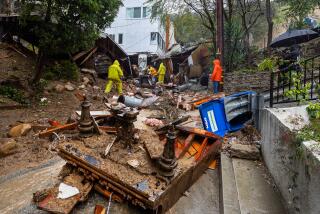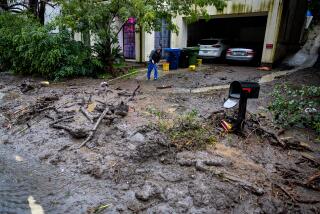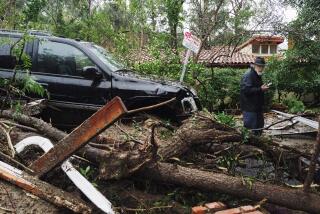Families Flee Rising Water; State Braces for New Storm
Heavy rains continued to batter storm-drenched Northern California on Wednesday, swelling rivers and reservoirs, knocking out electrical power and forcing families along the cresting Russian River to spend a frantic New Year’s Day fleeing their homes for evacuation centers.
The deluge--from a powerful series of storms that is expected to strike again over the weekend--forced the closure of Yosemite National Park and thwarted the search for three hikers missing on snow-shrouded Mt. Shasta, authorities said.
The storm caused 18 counties to declare local emergencies. Although Southern California has been spared the floods, the storm’s destructive fury reached the coastline here Wednesday: In Redondo Beach, 12-foot waves swept more than 20 sightseers and fishers off the breakwater rocks. Ten people--among them several children--were seriously injured and transported to a medical triage center, said Lt. Mike Cunningham, a Los Angeles County lifeguard.
Forecasters were predicting decreasing rain today and Friday, but a new storm, now moving through Hawaii, is expected to pummel California by Saturday night.
“Northern and Central California . . . really can’t take any more rain,” said Jon Erdman, a meteorologist with WeatherData Inc., which supplies forecasts for The Times. “What they need is four days to a week of drying, and some sunshine, and they’re just not going to get that.”
The new storm, though slightly smaller than the current one, is expected to drop an inch or two of rain in northern parts of the state and up to four inches in some mountain regions, Erdman said.
“Areas like the Napa River, the Russian River, they’ll have some flooding problems to deal with,” he said.
In Monte Rio, a tiny Russian River town that has taken some of the worst pounding in recent days, firefighters put on wetsuits Wednesday and took to small boats to rescue families and their pets from areas bracing for possible floods.
“So far, we’ve taken out eight people, three dogs, one cat and two bunnies,” said Rita Conway-O’Neill, an emergency medical technician with the Monte Rio Fire Department.
Standing in her wetsuit in the pouring rain, Conway-O’Neill said that people seemed more willing to evacuate this year than in 1995 or 1986, when floods inundated the communities of the Lower Russian River and forced emergency evacuations of hundreds of families.
“In 1995, people were very reluctant to leave their homes,” Conway-O’Neill said. “They figured: You live on the river, the water comes up and it goes down. But this time, a lot of them are leaving at the first sign of trouble.”
The Russian River crested at a record 48 feet during the 1995 floods, 16 feet above its flood level. But officials predicted that it would soon pass that mark, reaching as high as 49 feet by midnight Wednesday.
By Wednesday morning, hundreds of people had been evacuated from Guerneville, Monte Rio and the surrounding areas, said Harry Martin, a spokesman for the California Department of Forestry. The Air National Guard took to the skies in the afternoon, using five Black Hawk helicopters to make airborne rescues.
Some residents seemed resigned to the hardship of evacuation, while others made the difficult decision to stay with their homes--come hell or high water. Since the 1995 flood, many residents have raised their houses and stocked up on emergency supplies, “and those people are prepared for a siege,” Martin said.
“This is the first time we left,” said evacuee Kim Menary, 41, who stood in the Monte Rio fire station awaiting a county bus that would take her family to Sebastopol. She and her daughters, Krystal, 16, and Amanda, 12, had grabbed some clothes, their dog and their cat before National Guard members arrived in a military truck and scooped them aboard.
Before they arrived, Menary said, she had driven her car to the highest ground she could reach.
“We’ll stay with my mother in Sebastapol,” Menary said. In 1986 and 1995, she said, her basement and ground floor flooded during the heavy winter rains.
“It is always a mess to clean up,” she said. “It will take us a couple of days to get it back together. But we’re some of the fortunate ones. We have someplace to go.”
Evacuations were complicated by rugged terrain, narrow winding roads and thick stands of trees that make the landscape along the Russian River one of the state’s most beautiful vistas. By midmorning, several feet of water had sloshed across all roads leading into Guerneville, effectively sealing off the town of 2,000 to all but emergency crews.
Downed tree branches, leaves and other debris littered roads throughout the area as rain continued to pound without letup. Dormant grapevines poked through the several feet of water that covered acres of vineyards.
In Sebastopol, Jon Aplin was running the Red Cross shelter that opened Monday. In 1995, 250 people were evacuated to the shelter for as long as 10 days--most of them Guerneville residents.
“We have only seen about 70 people so far this time,” Aplin said. “That’s because people refuse to come off their property. But if the predictions are right, and the river goes to 49 feet tonight, they won’t have a choice.”
While children clustered around the shelter’s television, watching a cartoon video, a dozen adults sprawled on cots in the cavernous dormitory, some sleeping, others just staring blankly toward the ceiling.
Brian Rice, 38, sat with three of his friends and worried about his dog, a German shepherd, that he left in his Guerneville home Tuesday night while attending a New Year’s Eve party in Santa Rosa.
“When we tried to drive home this morning, the CHP stopped us and told us we couldn’t go into town,” Rice said. “They wouldn’t let me get my dog.”
This was the third time Guerneville has flooded in the 10 years Rice has lived there--he lost everything he owned in 1995, when his home filled almost to the ceiling with water--but he remains undaunted. He said he will never move.
“I’m just a river rat, I guess,” Rice said.
In more mountainous eastern areas, rain and snow forced dozens of road closures and brought a halt to efforts to find three hikers who left Thursday to ascend Mt. Shasta.
The three hikers left from a trail head at Bunny Flat, at 7,200 feet, where two feet of snow had fallen in recent days, said Susan Gravenkamp, a spokeswoman for the Siskiyou County Sheriff’s Department. Heavy rain was drenching the area Wednesday, making it impossible to fly search helicopters, she said.
Mudslides and huge boulders blocked the road to the area, preventing search crews from getting there on the ground, Gravenkamp said. In addition, there was severe avalanche dangers.
“It doesn’t look like we’ll be able to do anything [Thursday],” she said. “We think it will be some time before they will be able to clear that slide and get the road open.”
The three missing hikers were identified as Ted Knudsen, 27, of San Rafael, his brother Tim Knudsen, 23, of Solvang, and Sascha Paris, 27, of San Jose.
“Hopefully, they’re in a tent or they’ve built a snow cave or something like that,” Gravenkamp said, but conditions were very bleak. “It’s real severe weather on the mountain right now.”
More to Read
Sign up for Essential California
The most important California stories and recommendations in your inbox every morning.
You may occasionally receive promotional content from the Los Angeles Times.










